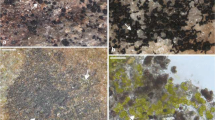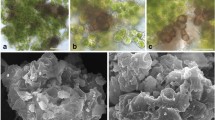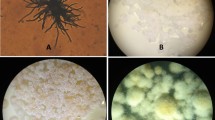Abstract
To understand the nature of a symbiotic relationship it is important to study the symbionts in different stages, from free-living to symbiosis. Lichens in the genus Usnea are mutualistic symbioses between Usnea spp., the mycobionts, and Trebouxia spp., the photobionts. In this study, in vitro experiments were conducted to isolate symbionts of several species of Usnea lichens and to produce axenic mycobiont and photobiont cultures. A co-culturing study was also carried out using the compatible, isolated symbionts to investigate the possibility of production of in vitro thalli. Usnea mycobionts were successfully isolated from different species, namely, U. articulata, U. ciliifera, U. inermis, U. pusilla, U. torulosa, and U. xanthopoga, and axenic cultures were prepared. Trebouxia photobionts were also isolated from the same species, except for U. articulata and U. xanthopoga. Although both dry and fresh lichen specimens were used in this study, the symbiont isolation was successful only from the fresh samples. The Usnea axenic cultures produced in this study were of two distinct morphological types. A phylogenetic analysis of fungal ITS data showed a clear relationship between the phylogenetic positions of cultured mycobionts and their morphological forms. In this study, the broth types of ‘Bold’s Basal’ and ‘Lilly and Barnett’ were the best growth media for the isolation of mycobionts and photobionts from Usnea thalli, respectively. These growth media were used in the co-culturing experiment and two in vitro thalli containing Usnea mycobionts and Trebouxia photobionts were produced. These isolation and co-culturing methods will be useful in future studies of the Usnea symbiosis.





Similar content being viewed by others
References
Ahmadjian V (1967) A guide to the algae occurring as lichen symbionts: isolation, culture, cultural physiology, and identification. Phycologia 6:127–160
Ahmadjian V (1973) Methods of isolating and culturing lichen symbionts and thalli. In: Ahmadjian V, Hale ME (eds) The lichens. Academic, New York, pp 653–665
Ahmadjian V (1993) The lichen symbiosis. Wiley, New York
Ahmadjian V, Jacobs JB (1982) Artificial re-establishment of lichens III. Synthetic development of Usnea strigosa. J Hattori Bot Lab 52:393–399
Ahmadjian V, Jacobs JB (1983) Algal-fungal relationships in lichens: recognition, synthesis and development. In: Goff LJ (ed) Algal symbiosis. Cambridge University Press, Cambridge, pp 147–172
Ahmadjian V, Jacobs J (1985) Artificial re-establishment of lichens IV. Comparison between natural and synthetic thalli of Usnea strigosa. Lichenologist 17:149–165
Behera BC, Verma N, Sonone A, Makhija U (2009) Optimization of culture conditions for lichen Usnea ghattensis G. Awasthi to increase biomass and antioxidant metabolite production. Food Technol Biotechnol 47(1):7–14
Deason TR, Bold HC (1960) Phycological studies I. Exploratory studies of Texas soil algae. University of Texas Publication, Austin, 6022:1–72
Drummond AJ, Suchard MA, Xie D, Rambaut A (2012) Bayesian phylogenetics with BEAUti and the BEAST 1.7. Mol Biol Evol 29:1969–1973
Galloway DJ (2007) Flora of New Zealand lichens. Manaaki Whenua Press, Lincoln
Gasulla F, Guéra A, Barreno E (2010) A simple and rapid method for isolating lichen photobionts. Symbiosis 51:175–179
Goodrich-Blair H, Ané J-M, Bever JD et al (2010) Symbiosis research, technology, and education: proceedings of the 6th International Symbiosis Society Congress held in Madison Wisconsin, USA, August 2009. Symbiosis 51(1):1–12
Guzow-Krzeminska B, Stocker-Worgotter E (2013) In vitro culturing and resynthesis of the mycobiont Protoparmeliopsis muralis with algal bionts. Lichenologist 45:65–76
Halonen P, Myllys L, Ahti T, Petrova O (1999) The lichen genus Usnea in East Fennoscandia. III. The shrubby species. Ann Bot Fenn 36:235–256
Hamada N (1996) Induction of the production of lichen substances by non-metabolites. Bryologist 99(1):68–70
Honegger R (2009) Lichen-forming fungi and their photobionts. In: Deising H (ed) Plant relationships, vol 5. Springer, Berlin, pp 307–333
Hussain A, Qarshi IA, Nazir H, Ullah I (2012) Palnt tissue culture: current status and opportunities. In Leva A, Rinaldi LMR (ed) Recent advances in plant in vitro culture. InTech, pp 1–28 doi: 10.5772/52760
Joneson S, Lutzoni F (2009) Compatibility and thigmotropism in the lichen symbiosis: a reappraisal. Symbiosis 47:109–115
Joneson S, Armaleo D, Lutzoni F (2011) Fungal and algal gene expression in early developmental stages of lichen-symbiosis. Mycologia 103:291–306
Kan Y, Pan J (2010) A one-shot solution to bacterial and fungal contamination in the green alga Chlamydomonas reinhardtii culture by using an antibiotic cocktail. J Phycol 46:1356–1358
Kranner I, Cram WJ, Zorn M, Wornik S, Yoshimura I, Stabentheiner E, Pfeifhofer HW (2005) Antioxidants and photoprotection in a lichen as compared with its isolated symbiotic partners. Proc Natl Acad Sci U S A 102:3141–3146
Li W, Zhou J, Guo S, Guo L (2007) Endophytic fungi associated with lichens in Baihua mountain of Beijing, China. Fungal Divers 25:69–80
Lilly V, Barnett H (1951) Physiology of the fungi. McGraw-hill book Co., New York
McDonald T, Gaya E, Lutzoni F (2013) Twenty-five cultures of lichenizing fungi available for experimental studies on symbiotic systems. Symbiosis 59:165–171
Miao V, Rabenau A, Lee A (1997) Cultural and molecular characterization of photobionts of Peltigera membranacea. Lichenologist 29:571–586
Nash TH III (2008) Lichen biology. Cambridge University Press, Cambridge
Piercey-Normore MD, DePriest PT (2001) Algal switching among lichen symbioses. Am J Bot 88:1490–1498
Posada D (2008) jModelTest: phylogenetic model averaging. Mol Biol Evol 25:1253–1256
Pratta G, Zorzoli R, Picardi LA (1997) Intra and interspecific variability of in vitro culture response in Lycopersicon (tomatoes). Braz J Genet. doi:10.1590/S0100-84551997000100014
Pyatt F (1973) Lichen propagules. In: Ahmadjian V, Hale ME (eds) The lichens. Academic, New York, pp 117–145
Randlane T, TõRra T, Saag A, Saag L (2009) Key to European Usnea species. In Thell A, Seaward MRD, Feuerer (ed) The diversity of lichenology: jubilee volume. J. Cramer in der Gebrüder Borntraeger Verlagsbuchhandlung, Berlin 100:419–462
Sanders WB (2001) Lichens: the interface between mycology and plant morphology. Bioscience 51(2):1025–1035
Sangvichien E, Hawksworth DL, Whalley AJ (2011) Ascospore discharge, germination and culture of fungal partners of tropical lichens, including the use of a novel culture technique. IMA Fungus 2(2):143–153
Stocker-Wörgötter E (2001) Experimental lichenology and microbiology of lichens: culture experiments, secondary chemistry of cultured mycobionts, resynthesis, and thallus morphogenesis. Bryologist 104:576–581
Stocker-Wörgötter E, Elix JA (2002) Secondary chemistry of cultured mycobionts: formation of a complete chemosyndrome by the lichen fungus of Lobaria spathulata. Lichenologist 34(4):351–359
Voicu D, Brezeanu A (2008) In vitro reactivity of Usnea barbata (L.) mott. Rom J Biol - Plant Biol 53:83–90
Wang XY, Wei XL, Luo H, Kim JA, Jeon HS, Koh YJ, Hur JS (2010) Plant hormones promote growth in lichen-forming fungi. Mycobiology 38:176–179
White T, Bruns T, Lee S, Taylor J (1990) Amplification and direct sequencing of fungal ribosomal RNA genes for phylogenetics. In Innis M, Gekfand D, Shinsky J, White T (ed) PCR protocols: a guide to methods and applications. Academic, pp 315–322
Yamamoto Y, Mizuguchi R, Takayama S, Yamada Y (1987) Effects of culture conditions on the growth of Usneaceae lichen tissue cultures. Plant Cell Physiol 28:1421–1426
Yamamoto Y, Miura Y, Higuchi M, Kinoshita Y, Yoshimura I (1993) Using lichen tissue cultures in modern biology. Bryologist 96(3):384–393
Yamamoto Y, Kinoshita Y, Yoshimura I (2002) Culture of thallus fragments and redifferentiation of lichens. In: Kranner I, Beckett R, Varma A (eds) Protocols in lichenology: culturing, biochemistry, ecophysiology, and use in biomonitoring. Springer, Heidelberg, pp 34–46
Yoshimura I, Kurokawa T, Yamamoto Y, Kinoshita Y (1993) Development of lichen thalli in vitro. Bryologist 96(3):412–421
Yoshimura I, Yamamoto Y, Nakano T, Finnie J (2002) Isolation and culture of lichen photobionts and mycobionts. In: Kranner I, Beckett R, Varma A (eds) Protocols in lichenology. Springer, Berlin, pp 3–33
Acknowledgments
We thank the Brian Mason Scientific & Technical Trust, the Canterbury Botanical Society, and Lincoln University for providing research funding. Thanks to David Orlovich, Michele Piercey-Normore, David Richardson and two anonymous reviewers for their helpful comments on this research.
Author information
Authors and Affiliations
Corresponding author
Rights and permissions
About this article
Cite this article
Rafat, A., Ridgway, H.J., Cruickshank, R.H. et al. Isolation and co-culturing of symbionts in the genus Usnea . Symbiosis 66, 123–132 (2015). https://doi.org/10.1007/s13199-015-0343-1
Received:
Accepted:
Published:
Issue Date:
DOI: https://doi.org/10.1007/s13199-015-0343-1




